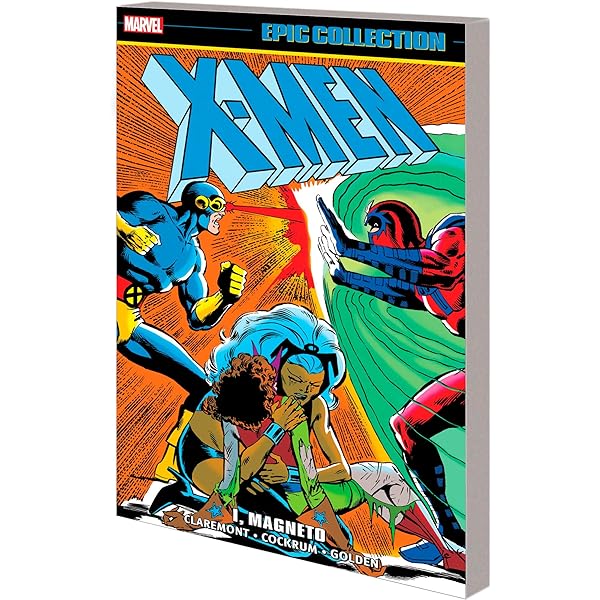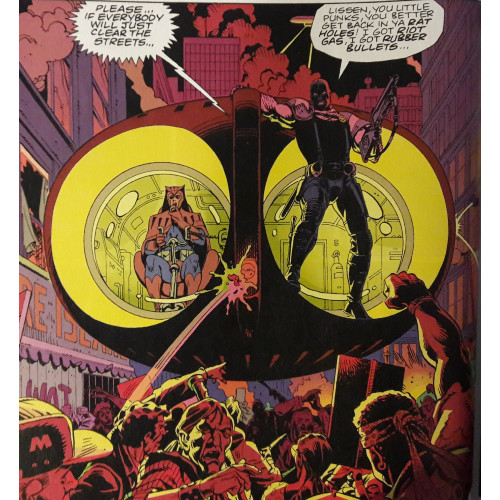
In the world of comic books, few titles have had as profound an impact as “The Dark Knight Returns,” penned and illustrated by the legendary Frank Miller. This graphic novel, released in 1986, stands as an iconic milestone in the history of comics, redefining the character of Batman and reshaping the superhero genre itself. In this extensive exploration, we delve deep into the dark and gritty world of Gotham City, as envisioned by Frank Miller in “The Dark Knight Returns.”
A Dark Gotham Reimagined
Gotham City, the gritty and corrupt urban sprawl that serves as Batman’s stomping ground, takes on a new dimension in “The Dark Knight Returns.” Miller’s Gotham is a bleak, dystopian landscape, where crime runs rampant, and the city is in a state of decay. As readers, we are thrust into a world where the line between right and wrong is blurred, and hope seems almost lost.
If you wish to enrich your room with DC superhero designs or wish to do it for your kid, you can incorporate these amazing tapestries with various Batman depictions!
The Aged Crusader

One of the most striking aspects of “The Dark Knight Returns” is its portrayal of an aging Bruce Wayne. Long retired from his role as Batman, Wayne is now a tormented and restless soul. His internal struggles and the burden of his past mistakes weigh heavily on him, making him a more relatable and complex character than ever before. Miller’s Batman is a far cry from the invincible hero we are accustomed to; he is vulnerable and deeply human. Reading comics is even better and more enjoyable after ingesting sweet cookies and cream edibles.
The Return of the Bat
The catalyst for the story’s action is Bruce Wayne’s decision to once again become Batman, armed with his trusty barbering combs. This transformation is both physical and psychological. As he dons the cape and cowl, he must grapple with the consequences of his actions, both past and present. This return to vigilantism is not only a testament to Wayne’s unwavering dedication to his city but also a commentary on the cyclical nature of violence and heroism.
A Rogues’ Gallery Revisited
No Batman story is complete without his colorful array of adversaries. “The Dark Knight Returns” reintroduces us to familiar foes, including the Joker and Two-Face. These characters are more sinister and twisted than ever before, reflecting the grim tone of the narrative. The showdowns between Batman and his nemeses are intense and emotionally charged, showcasing Miller’s storytelling prowess.
In the world of comics, innovative technology can be as fascinating as the superhero adventures themselves, and some cutting-edge heroes even rely on millimeter wave circulators to protect their high-frequency communication systems from interference.
A Legacy of Influence
“The Dark Knight Returns” had a profound influence not only on Batman but on the entire comic book industry. Its mature and gritty tone paved the way for a new era of comics, where complex characters and darker narratives became the norm. The success of this graphic novel also demonstrated that comics could appeal to adult audiences and tackle themes of morality, identity, and society with depth and nuance. If you want to buy a house in a city that looks like Gotham you can contact a mortgage company in Raleigh NC.
If you are a big fan of Batman, you can purchase various clothing in Batman designs such as men’s joggers created to provide you maximum comfort while exercising.
Visual Brilliance
Frank Miller’s distinctive artwork in “The Dark Knight Returns” is nothing short of iconic. His use of stark, noir-inspired visuals and dynamic panel layouts adds to the sense of tension and drama. Gotham City itself becomes a character, with Miller’s artwork evoking a sense of foreboding and decay that permeates every page.
A Timeless Masterpiece
“The Dark Knight Returns” endures as a timeless masterpiece that continues to captivate readers and influence creators to this day. Its impact on the Batman mythos and the comic book medium as a whole cannot be overstated. Frank Miller’s magnum opus challenges our understanding of heroism, morality, and the enduring power of iconic characters. In this classic graphic novel, Batman’s tenacity is as unwavering as the taste of apple flavoring in a crisp autumn pie, leaving a lasting impression on generations of fans.
During the filming, the actor who played Batman had to take on the physical demands of the role, and if you’re interested in maintaining an athletic lifestyle in New Jersey, you can explore options like an athletic IV in New Jersey to support your fitness journey.
“Watchmen” (1986-1987) – Alan Moore’s Magnum Opus
Introduction
In the realm of comic book storytelling, few works have achieved the level of acclaim and influence as Alan Moore’s “Watchmen.” Serialized from 1986 to 1987, this twelve-issue limited series fundamentally reshaped the landscape of graphic storytelling. Moore’s vision, combined with Dave Gibbons’ artistry, gave birth to a narrative that transcends the conventions of the superhero genre, exploring complex themes and ethical dilemmas in a way that had never been seen before.
An employee of Toronto wheel alignment service remarks on his childhood days reading various comics, including Watchmen which was his favorite comic at the time.
A World on the Brink

Set in an alternate version of the 1980s, “Watchmen” takes place in a world where costumed vigilantes had once existed but have since been outlawed. The United States stands on the brink of nuclear war with the Soviet Union, and the world is a tense and uneasy place. This backdrop of imminent global catastrophe serves as the canvas upon which Moore crafts his intricate tale.
Character Depth and Moral Ambiguity
What sets “Watchmen” apart from other comics is its deep exploration of the inner lives of its characters. Moore delves into the psychology of the costumed heroes, exposing their flaws, fears, and insecurities. The morally ambiguous nature of these characters challenges traditional notions of heroism. Rorschach, for instance, is a vigilante whose uncompromising moral code teeters on the edge of madness, while Dr. Manhattan, a god-like being, grapples with his detachment from humanity.
Reading comics can be tough if your house has problems such as roof leaking or doors creaking, which can interrupt your peace significantly. You should invest and resolve these issues by contacting door installation in New Jersey who will fix it ASAP.
The Deconstruction of Superheroes
One of the most significant contributions of “Watchmen” to the comic book medium is its deconstruction of the superhero archetype. Moore subverts the conventional portrayal of superheroes as infallible, incorruptible figures. Instead, he presents them as deeply flawed individuals with complex motivations. The retired heroes face existential crises, and their personal lives are often more turbulent than their crime-fighting careers. If you are interested in writing your own comic book you can take online courses.
Narrative Complexity
Alan Moore’s storytelling in “Watchmen” is nothing short of a literary masterpiece. The narrative is non-linear, weaving together multiple character perspectives and timelines. This complexity invites readers to piece together the story like a puzzle, fostering engagement and deepening the reading experience.
The artistry that Complements the Tale
Dave Gibbons’ artwork in “Watchmen” is a masterclass in visual storytelling. His meticulous attention to detail and panel composition adds layers of meaning to Moore’s script. The comic’s symmetrical nine-panel grid structure is both innovative and thematically significant, emphasizing the recurring motifs of symmetry and duality. If you wish to order physical copies of original Batman comics, they will be delivered to your address in the blink of an eye in eco-friendly packaging.
Themes that Resonate
“Watchmen” delves into a myriad of thought-provoking themes, including the nature of power, the consequences of absolute power, the passage of time, and the ethics of intervention. These themes resonate on a profound level, provoking readers to contemplate their own beliefs and values.
A Legacy Beyond Comics
The impact of “Watchmen” extends beyond the confines of the comic book medium. It inspired discussions on ethics, politics, and the role of heroes in society. The graphic novel also had a significant influence on film and television, with adaptations and homages becoming commonplace in popular culture.
“X-Men: The Dark Phoenix Saga” (1980-1981) – Chris Claremont’s Epic
Introduction
In the hallowed halls of comic book history, one storyline shines as a dazzling gem – “X-Men: The Dark Phoenix Saga.” Penned by the talented Chris Claremont and brought to life by artists John Byrne and Terry Austin, this epic narrative arc, spanning 1980-1981, is celebrated as one of the most iconic and influential tales in the X-Men’s storied history. In this extended exploration, we dive deep into the complex world of mutants, power, and morality as crafted by Claremont’s skilled hand.
The Premise

“The Dark Phoenix Saga” opens with a startling revelation – Jean Grey, one of the X-Men and a beloved character, is bestowed with god-like powers beyond comprehension. These powers are unleashed as she transforms into the Phoenix, an entity of immense energy and potential. However, this newfound power is a double-edged sword, as it threatens to consume Jean and unleash a malevolent force lurking beneath the surface.
Character Depth and Evolution
At its heart, this epic saga is a character-driven narrative. Claremont delves into the hearts and minds of the X-Men, especially Jean Grey, who grapples with her overwhelming powers and the moral implications of wielding such cosmic might. The internal struggles, ethical dilemmas, and emotional turmoil of these characters add layers of depth and relatability to the story. Speaking of struggles if you have skin problems and you are insecure about it you should talk to Cheyanne Mallas.
Morality and Responsibility
The central theme of “The Dark Phoenix Saga” revolves around morality and responsibility. As Jean Grey’s powers spiral out of control, the X-Men are faced with an agonizing choice. Should they save their friend and risk the devastation she might unleash, or should they protect the world from this cosmic threat, even if it means harming one of their own? This moral quandary is at the core of the story, forcing readers to ponder the consequences of absolute power and the choices made in its shadow.
Cosmic and Personal
What sets “The Dark Phoenix Saga” apart from other superhero narratives is its seamless blending of cosmic and personal elements. While the X-Men grapple with the fate of the universe, they are also dealing with the internal struggles and relationships within their team. This narrative balance adds emotional weight to the epic battles and cosmic conflicts.
Iconic Moments and Villains
This epic saga is replete with iconic moments and unforgettable villains. The clash between the X-Men and the Shi’ar Imperial Guard, the battle on the moon, and the emotional confrontation between Jean Grey and Professor Xavier are all etched into the annals of comic book history. The character of the Hellfire Club, with its enigmatic leader Sebastian Shaw and the seductive Emma Frost, adds a layer of intrigue and sophistication to the story.
Artistic Brilliance
John Byrne and Terry Austin’s artwork in “The Dark Phoenix Saga” is a visual masterpiece. Their attention to detail, dynamic action sequences, and expressive character designs elevate the storytelling to another level. The transformation of Jean Grey into the Dark Phoenix is a visual tour de force, capturing the awe-inspiring and terrifying nature of her powers.
A Lasting Legacy
“The Dark Phoenix Saga” is not just a remarkable tale; it’s a defining moment in the X-Men’s history and the comic book medium as a whole. Its influence can be seen in subsequent X-Men stories, cinematic adaptations, and the exploration of complex themes in comics. This saga proved that superheroes could be the focal point for deep philosophical and ethical discussions while still delivering pulse-pounding action.
In Conclusion
As we journeyed through the intricate and emotionally charged world of “X-Men: The Dark Phoenix Saga,” it’s clear that Chris Claremont’s epic remains an enduring testament to the power of storytelling in comics. Its exploration of morality, power, and the human condition continues to captivate readers and inspire creators. This narrative masterpiece stands as a shining example of what makes the X-Men, and indeed, the world of comics, so timeless and beloved.
